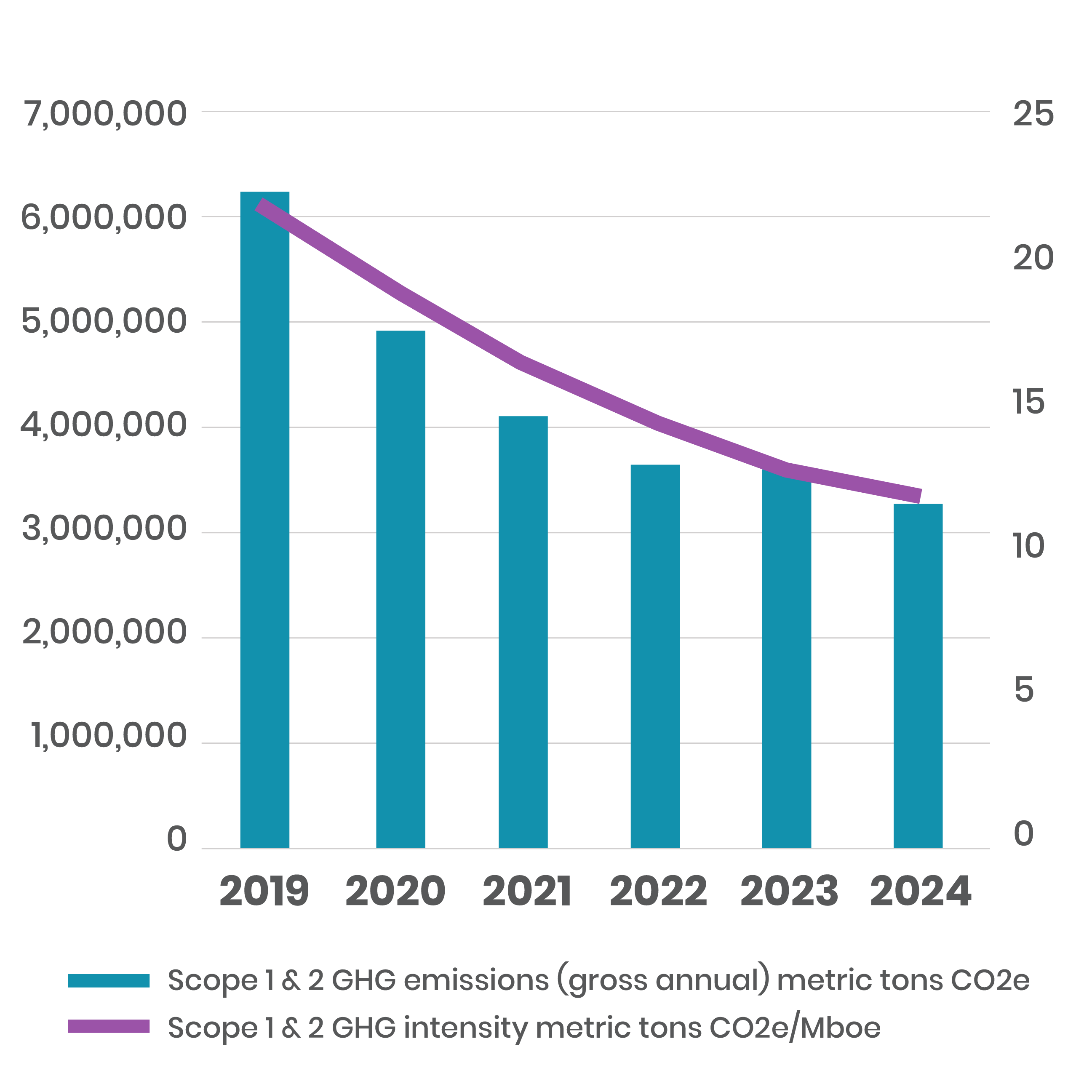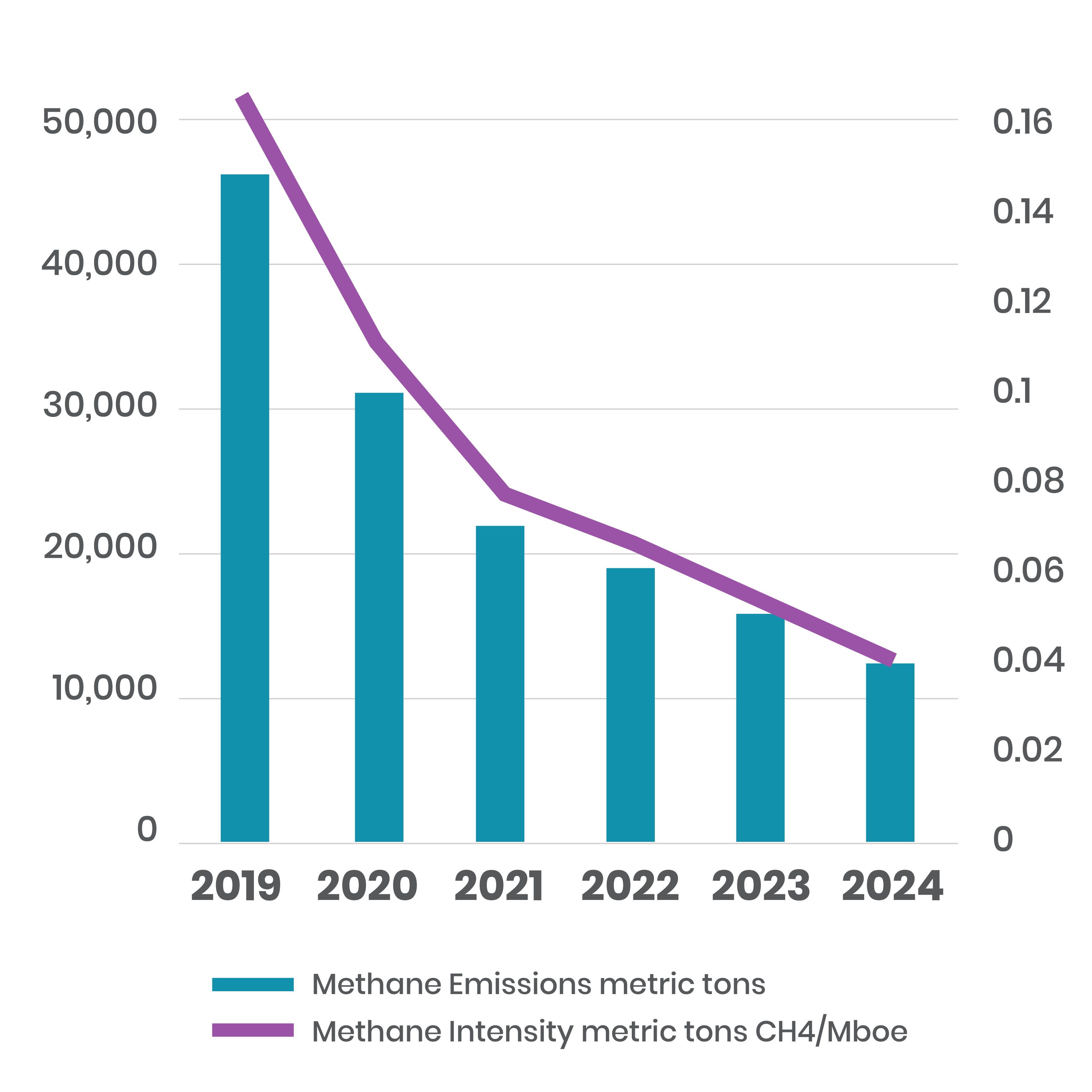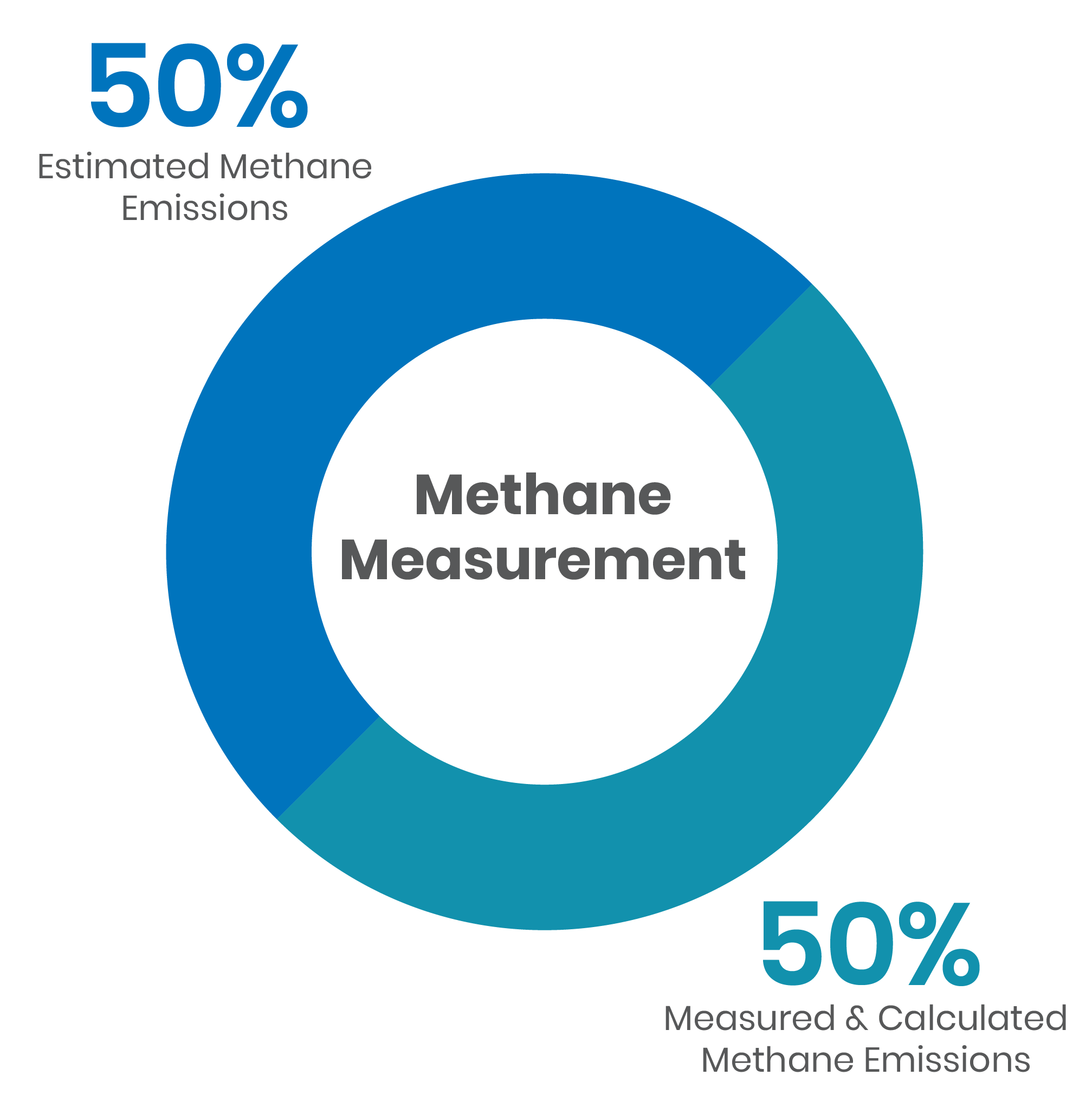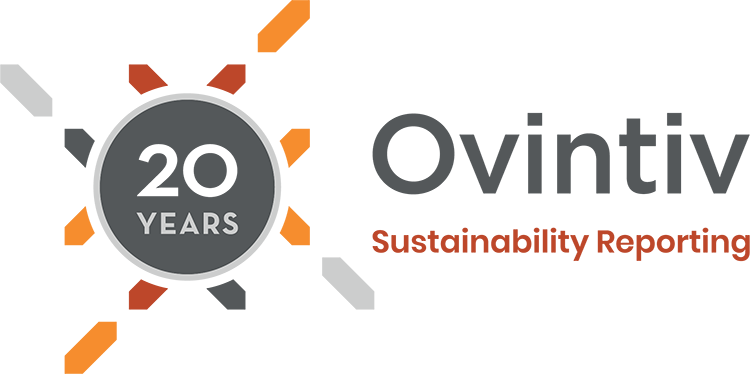EMISSIONS MEASUREMENT AND MANAGEMENT
We are committed to reducing our air impact through strategic design, innovation and efficiency for the lifecycle of our operations.
Ovintiv’s Approach
Measuring and Managing Emissions
For sustainability reporting, we disclose gross operated emissions according to jurisdictional requirements and industry standards. We must also report our emissions to federal, state or provincial regulatory bodies. We use multiple methods to determine our emissions depending on the emission type and source including estimates, calculations and measurements. Our formulas are aligned with the Environmental Protection Agency (EPA) and the GHG Protocol and may consider manufacturers’ specifications, equipment run-time, fuel, flare and vent gas compositions, and production volumes, among other inputs.
Gross Emissions Data Sources
Gross operated emissions include:
Scope 1 GHG emissions:
Direct emissions from activities occurring at our operations which are owned or controlled by Ovintiv. We are the operator for over 95% of our production volumes. Sources include fuel combustion, flaring, venting and fugitives.
Scope 2 GHG emissions:
Indirect GHG emissions from our use of purchased electricity, heat or steam.

Scope 3 GHG emissions:
Indirect emissions from activities related to our operations but occurring from sources that Ovintiv does not own or control, including from the end use of our products. We do not report Scope 3 GHG emissions as data for this reporting is often unavailable, incomplete or unreliable and therefore can be inaccurate and misleading.
Emissions Performance Monitoring
To better harness our information and support operational decision-making, we have created emissions dashboards that allow us to monitor our emissions performance, quickly identify opportunities for reduction as well as easily extract data for peer benchmarking. In an effort to increase the accuracy of our Scope 2 emissions tracking, we have also digitized and automated the processing of over 1,000 monthly electricity usage invoices through Ovintiv’s data pipeline.
To further leverage our emissions data, we have developed a multi-disciplinary GHG forecasting process that integrates a variety of factors including operational data and impacts of changing regulations. This helps us manage our GHG emissions and ensure we are on track to meet our reduction target.
We use intensity metrics for benchmarking and goal setting to provide context and increase our consistency and comparability. Since 2019, we have demonstrated measurable progress against our emissions reduction goals, reducing our methane intensity by ~73% and achieving a >45% reduction in our Scope 1 & 2 GHG emissions intensity.
Scope 1 & 2 GHG Emissions

Methane
Emissions

We have decreased our absolute Scope 1 & 2 GHG emissions by more than 45% and our methane emissions by more than 70% since 2019.
Methane Emissions Measurement
We currently employ source-level estimates, calculations, and parametric measurement to determine our methane emissions. In 2024, approximately half of our methane emissions were estimations, however as technologies improve and we continue to track and monitor more equipment, we anticipate that the percentage of estimated versus measured/calculated methane emissions will continue to decline.
Estimated Emissions:
Utilizes emission factors multiplied by an equipment count or manufacturer data
Calculated Emissions:
Utilizes parametric measurement such as fuel usage, engineering calculations, or flow rate
Measured Emissions:
Utilizes the direct measurement of methane

Oil & Gas Methane Partnership 2.0
The Oil & Gas Methane Partnership 2.0 (OGMP 2.0) is the United Nations Environment Programme’s measurement-based oil and gas reporting and mitigation framework. It has five levels of compliance, with increasing direct measurement requirements and timelines associated with each level.
Ovintiv is not currently an OGMP 2.0 partner. While we are aligned with its ambition, we consider our current strategy to achieve our GHG emissions intensity target as the best path forward. To demonstrate our progress in reducing our methane emissions intensity, we undertook a self-assessment process that showed Ovintiv’s approach is currently aligned with OGMP 2.0 for levels 1 – 3 and partially aligns with level 4. We have piloted site-level direct measurement in select operations, however we currently do not widely employ direct measurement technology across our operations. As noted by OGMP 2.0, the wide use of methane sensing technologies to reach their stated level 4 or 5 compliance may prove unviable until technologies advance, despite companies acting in good faith to identify and commercialize these technologies. While we strive to continuously improve our reporting and evaluate the potential for future applicability of direct measurement in our emissions measurement and monitoring program, at this time it is uncertain when we will achieve Company-wide performance equivalent with level 4. Ongoing compliance activities to meet new and emerging regulations will continue to progress Ovintiv towards increased levels of direct measurement and reporting.
Ovintiv Alignment to OGMP 2.0
OGMP 2.0
Recommended Disclosures
OGMP 2.0 Description
Ovintiv Response
Methane Emission Reduction Target
Company Performance Target (one of the following):
- 45% reduction by 2025
- 60-75% reduction by 2030
- Near zero emissions intensity
Achieved an intensity reduction of ~73% through year-end 2024 from 2019 levels.
Level 1 Reporting
Venture/Asset Reporting:
- Single, consolidated emissions number
- Only applicable where company has very limited information
Report emissions by detailed source type utilizing engineering calculation, activity factors, measurement, and emission factors.
Level 2 Reporting
Emissions Category:
- Emissions reported based on IOGP and Marcogaz emissions categories
- Based on generic emission factors
Report emissions by detailed source type utilizing engineering calculation, activity factors, measurement, and emission factors.
Level 3 Reporting
Generic Emission Source Level:
- Emissions reported by detailed source type
- Based on generic emission factors
Report emissions by detailed source type utilizing engineering calculation, activity factors, measurement, and emission factors.
Level 4 Reporting
Specific Emission Source Level:
- Emissions reported by detailed source type using specific emissions and activity factors
- Based on direct measurement or other methodologies
- Achieved within 3 years
Report emissions by detailed source type utilizing engineering calculation, activity factors, measurement, and emission factors. Ovintiv reports Level 4 at ~50% of sources (70% needed for full Level 4). At this time it is uncertain when we will achieve Company-wide performance equivalent with level 4.
Level 5 Reporting
Level 4 + Site Level Measurement Reconciliation:
- Integrating bottom-up source-level reporting with independent site-level measurements
- Site-level measurements: direct measurement technologies at a site or facility level on a representative sample of facilities
- Achieved within 5 years
Ovintiv has utilized site-level measurements but does not currently incorporate into emissions reporting or go through a reconciliation process.
Non-operated Assets
Commitment to work with non-operated ventures demonstrating reasonable endeavors to help them reach progressively L4/5 reporting in 5 years.
Leak Detection and Repair (LDAR)
Tracking and reporting methane emissions and intensity allows us to consistently benchmark our methane emissions reduction efforts throughout our operations. LDAR has been part of Ovintiv’s emissions management practice for nearly 20 years. Our monitoring programs are designed to comply with local and federal LDAR regulations. Surveys typically occur on a bi-monthly, quarterly or semi-annual basis depending on requirements, inspections and directed maintenance.
Using optical gas imaging (OGI) cameras, we can identify leaks and initiate repairs to reduce methane emissions on-site.
In 2024, we conducted more than 4,600 LDAR surveys using OGI cameras.
When we detect a leak, our program includes three components for continuous improvement:
Repair
Our OGI surveyors are trained in leak repair and service leaks upon detection.
Documentation
We use a digital logging system, which automatically integrates with our compliance system, to track inspection dates, findings and repairs.
Data Analysis and Maintenance
By analyzing LDAR survey data, we identify trends and specific facilities, components and equipment with greater potential for leaks. We proactively direct inspection and maintenance activities for these sites to reduce the risk of potential leaks. To facilitate clear communication of LDAR data trends, we created an LDAR analytics dashboard. This innovative tool generates facility improvement strategies and identifies the root causes of leaks in a more efficient manner, saving valuable time and resources.
